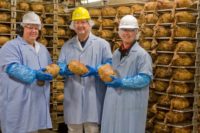Stacking the decks
Interleaving and stacking of proteins continues to assist processors in offering convenient, easy-to-use, pre-portioned products.


|
Tim Biela, executive vice president, food safety and quality assurance, for AFA Foods, agrees that the interleaving process is a fairly typical one across the industry, but notes that it does vary in terms of benefits for particular products.
“It is truly functional depending on the type product being produced and what its intended use is,” he says. AFA Foods uses wax paper interleaves on fresh products to assist in separating and handling products. For frozen patties, Biela says, interleaving is not necessary if the product is intended to be used in a frozen state.
“Properly frozen ground beef patties do not stick together,” he explains. “The whole purpose of freezing is to bind the moisture in the product so ice crystals do not form on the surface.”
Frozen patties that stick together for the end user, even with interleave papers in between them, are an indication of improper freezing of the product during manufacture or possible temperature abuse.
“If the product is not frozen properly on the line and then placed into a freezer, moisture will sublimate from the interior of the product to the surface creating the potential for product sticking,” he says. “This can also occur if the product is tempered allowing the moisture to sublimate to the surface when placed back into a freezer.”
Restaurants that are tempering frozen products will specify that they require paper interleaves so the products are easier to handle and separate, Biela adds.
Interleaving isn’t only for ground patties, however. It can be used on a variety of products, as indicated by the ways in which some businesses are using the papers on their products.
One such example is the Sub Sandwich Kits offered by Lansing, Ill.-based Land O’Frost. The kits, which come in two varieties, contain 24 ounces of meat separated into pre-portioned, shingled servings of lunchmeat separated by interleaved paper. The kits boast enough lunchmeat to create 12 6-inch sub sandwiches, with the flavors grouped together within the package.
In fact, the Italian-Style Sub Sandwich Kit carries a label touting the benefits of the interleaved portions, stating:
“Layered for Easy Prep!” over an image of the portioned meats and the interleave paper, making the product attractive from a consumer convenience standpoint.
Furthermore, many Subway restaurants use pre-portioned deli meat “setups” separated by interleaved paper, allowing its employees to simply flip the pre-portioned lunchmeats onto the bread based on the sandwich ordered, making sandwich construction more efficient and simplistic.
Geoff Feil, Oscar Mayer brand manager, says that interleaving and stacking does have its challenges that many processors must consider when incorporating the process into its lines.
“The greatest challenge in interleaving and stacking is matching performance with slicing capability,” Feil explains. “Current commercially available interleaving and stacking equipment are slower than commercially available slicers, so manufacturers need to address that gap with custom equipment.”
Once processors synchronize their interleaving/stacking machines with the rest of their operation, however, it can be smooth sailing, to the benefit of the customers, who don’t have to wrestle with product that either sticks together or is not pre-portioned for convenience.
In frozen ground-beef patty applications, Biela explains that processors need to be cognizant of the handling of patties in relation to interleave papers. In this process, the wax paper is placed under the patty when it is formed and is still not frozen.
“The patties usually are dropped from the conveyor at the end of the freezing line into an RMF Patty Stacker, so the patties are not flat but on their side in the stacker,” he says. “This does create the potential for the patty to lose its paper.”
Biela says one way to combat this situation is to keep the patties flat and drop them, one at a time, in a stack. An indexing conveyor can build stacks of patties and move them forward for packaging with a decreased risk of the loss of the interleave paper.
So long as the proper technology is used for applying the interleave papers, Biela concludes, production efficiency typically will not be affected in ground beef patty applications.
Looking for a reprint of this article?
From high-res PDFs to custom plaques, order your copy today!





